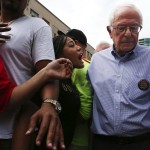An old division is rearing it’s head again in the Democratic Party. It’s gone public in the disruption of Bernie Sanders’s speeches by #blacklivesmatter protesters, first at Netroots Nation in July and then again in Seattle on Saturday (see here). For those who consider themselves left, liberal, or sympathetic to these movements in general, such disruptions can be confusing. Aren’t Sanders and the protesters both on the same “side”? Only if we reduce everything to the standard liberal/conservative binary.
Looking more closely at the liberal wing of the Democratic Party, we find a continuing division between those whose focus on racism and those who focus on class. Sanders represents the latter group, which can be traced through the Occupy movement and back to original New Deal priorities. As a left-populist, his focus has been on economic security, with Wall Street serving as a primary villain.
In contrast, the Black Lives Matter protesters can trace their lineage to the mid-century Civil Rights Movement, with its demand that the United States address systematic racism, a fight that is still very much in progress. While they sometimes made common cause with those focused on class, the two movements aren’t automatically aligned. Just as often, those focused on racism have seen candidates like Sanders as implicitly contributing to the problem of systematic racism by treating it as a secondary issue. Similarly, protests focused on race can frustrate economic populists because their seem to narrow the debate.
In this context, the struggle between Sanders and these protesters isn’t that surprising. It’s part of the regular campaign process of the party working out it’s priorities. Both groups are struggling for control of Sanders’s agenda and by extension control of party resources. Sanders has responded by trying to build a bigger tent, encompassing both groups (as in his speech Saturday night and his hiring of a new campaign secretary).
So the real question is, what about Clinton? Why hasn’t she faced such public pressure? Part of this is quality campaigning: She skipped Netroots Nation (knowing it wasn’t a sympathetic audience) and hasn’t done many large public events yet (because she doesn’t have to). Part of it may also be that she has stronger ties with both wings of the party. Though Obama has overshadowed this, the Clinton’s were once seen as particularly close to black activists. She may have successfully courted enough economic liberals to tamp down their criticism. It helps that Sanders has so far chosen not to go negative on her, buying her some more time before addressing these issues.
It will be most interesting to see what happens when Clinton begins to campaign more publicly. Will she feel the need to embrace economic populism? Or will she ally herself with anti-racism activists as a counter to Sanders? Either approach would seem to pull her leftward, away from the centrist position she’d prefer to cultivate for the general election.
Latest posts by Jason LaBau (see all)
- Take Down the Confederate Monuments - August 14, 2017
- The Democratic Split - August 10, 2015
- On Lincoln and Our Second Founding - July 6, 2015

